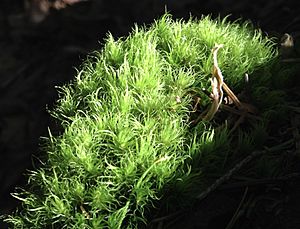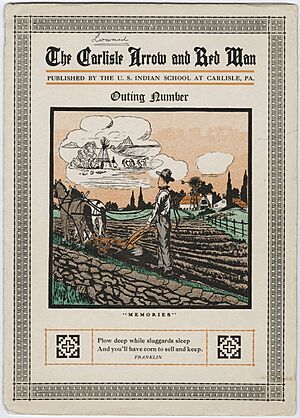Robin Wall Kimmerer facts for kids
Quick facts for kids
Robin Wall Kimmerer
|
|
|---|---|

Kimmerer in 2023
|
|
| Born | September 13, 1953 |
| Nationality | Citizen Potawatomi Nation American |
| Alma mater | SUNY-ESF (BS) University of Wisconsin–Madison (MS, PhD) |
| Known for | Scholarship on traditional ecological knowledge and moss ecology; Outreach to tribal communities; Creative writing |
| Awards | John Burroughs Medal Award, for Gathering Moss MacArthur Fellowship |
| Scientific career | |
| Fields | Plant ecology, Botany |
| Institutions | SUNY-ESF Centre College Transylvania University |
| Thesis | Vegetation Development and Community Dynamics in a Dated Series of Abandoned Lead-Zinc Mines in Southwestern Wisconsin (1983) |
Robin Wall Kimmerer was born on September 13, 1953. She is a Potawatomi botanist and a well-known author. She also leads the Center for Native Peoples and the Environment at the State University of New York College of Environmental Science and Forestry (SUNY-ESF).
As a scientist and a Native American, Kimmerer uses both Western science and Indigenous environmental knowledge in her work. She believes both ways of understanding nature are important.
Kimmerer has written many scientific articles. She has also written several books. These include Gathering Moss: A Natural and Cultural History of Mosses (2003) and Braiding Sweetgrass: Indigenous Wisdom, Scientific Knowledge, and the Teachings of Plants (2013). Her other books are The Democracy of Species (2021) and The Serviceberry: Abundance and Reciprocity in the Natural World (2024). She even narrated an audiobook version of Braiding Sweetgrass in 2016.
Contents
Early Life and Education
Robin Wall Kimmerer was born in 1953 in upstate New York. Her parents, Robert and Patricia Wall, encouraged her love for nature. Spending time outdoors helped her deeply appreciate the environment. Kimmerer is a registered member of the Citizen Potawatomi Nation.
For college, Kimmerer stayed close to home. She attended the State University of New York College of Environmental Science and Forestry. In 1975, she earned her bachelor's degree in botany, which is the study of plants.
After college, she worked for two years as a microbiologist. Then, Kimmerer moved to Wisconsin to continue her studies. She attended the University of Wisconsin–Madison. There, she earned her master's degree in botany in 1979. She then completed her PhD in plant ecology in 1983. During her studies, she learned about mosses. Mosses later became a main focus of her scientific work.
Career and Teaching

After finishing her studies in Wisconsin, Kimmerer moved to Kentucky. She taught briefly at Transylvania University. Later, she moved to Danville, Kentucky, and taught at Centre College. At Centre College, she taught biology, botany, and ecology.
In 1993, Kimmerer returned to her home state of New York. She began teaching at her old college, ESF, where she still works today. She teaches in the Environmental and Forest Biology Department. Her courses cover topics like land and culture, traditional ecological knowledge, and the ecology of mosses.
Kimmerer is also the director of the Center for Native Peoples and the Environment at ESF. This center helps Indigenous students study environmental science. It also helps science learn from Native wisdom. The goal is to work together for a more sustainable future.
Combining Knowledge Systems

Kimmerer strongly supports the Traditional Ecological Knowledge (TEK) approach. She describes TEK as a "way of knowing." It is based on long-term observation and deep connections with nature. TEK also includes cultural and spiritual ideas.
As a botanist trained in Western science, Kimmerer respects both TEK and Western science. She calls using both "two-eyed seeing." This means looking at the world through both scientific and Indigenous lenses. She believes both ways of thinking are valuable.
Kimmerer's work is partly inspired by her family's past. Her grandfather, who was also Citizen Potawatomi, attended the Carlisle Indian Industrial School. This school aimed to "civilize" Native children. It stopped them from speaking their language and tried to erase their Native culture. Knowing how important language is, Kimmerer took Potawatomi language classes. She believes that "when a language dies, so much more than words are lost."
Her current work involves traditional ecological knowledge, studying mosses, and working with Indigenous communities. She also enjoys creative writing.
Community Involvement
Kimmerer has helped with projects like the Undergraduate Mentoring in Environmental Biology (UMEB). This program connects students of color with professors in environmental biology. They work together on research projects.
She is also part of the United States Department of Agriculture's Higher Education Multicultural Scholars Program. This program gives students real-world experience in solving complex problems. Kimmerer is involved with the American Indian Science and Engineering Society (AISES). She also works with the Onondaga Nation's school on community outreach.
Kimmerer uses both traditional knowledge and science to help restore natural areas. She has served on the advisory board for the SEEDS program. This program aims to increase the number of minority ecologists. She also used to lead the Traditional Ecological Knowledge Section of the Ecological Society of America.
In April 2015, Kimmerer was invited to speak at a United Nations meeting. She discussed how living in harmony with nature can help protect natural resources. This meeting was about achieving sustainable development goals.
Awards and Recognition
Kimmerer received the John Burroughs Medal Award for her book, Gathering Moss: A Natural and Cultural History of Mosses. This book combined her experience as a plant ecologist with traditional knowledge about nature.
Her second book, Braiding Sweetgrass: Indigenous Wisdom, Scientific Knowledge, and the Teachings of Plants, won the 2014 Sigurd F. Olson Nature Writing Award. Braiding Sweetgrass explores how people and the natural world depend on each other. She won another Burroughs award for an essay called "Council of the Pecans" in 2013. Within ten years of its release, over two million copies of Braiding Sweetgrass were sold worldwide.
In 2020, she received an honorary degree from College of the Atlantic. In 2022, Kimmerer was given a MacArthur Fellowship. This is a special award for talented individuals. In 2025, she was included on the Time 100 list of influential people.
Books by Robin Wall Kimmerer
- Gathering Moss: A Natural and Cultural History of Mosses (Oregon State University Press, 2003) ISBN: 0-87071-499-6.
- Braiding Sweetgrass: Indigenous Wisdom, Scientific Knowledge, and the Teachings of Plants (Milkweed Editions, 2013) ISBN: 9781571313355.
- The Serviceberry (Scribner, November 19, 2024) ISBN: 9781668072240
See also
 In Spanish: Robin Wall Kimmerer para niños
In Spanish: Robin Wall Kimmerer para niños

